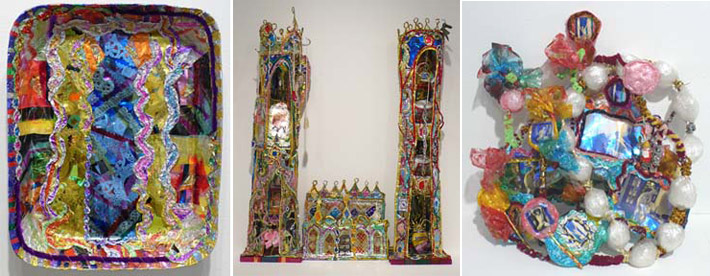Lanigan-Schmidt: Eye Candy for the Soul
The first time I saw one of Thomas Lanigan-Schmidt's incredible encrusted installations was at Holly Solomon's 724 Fifth Avenue Gallery, in 1992. On view was a reconstruction of "The Summer Palace of Czarena Tatlina," which originally occupied the artist's East Village apartment in 1970.
This is what Roberta Smith, art critic for the New York Times, said about it: "Making extensive use of the cheapest of materials - brightly colored aluminum foil, tinted cellophane and plastic wrap - the artist has created a delicately trashy feast for the eyes. On walls papered with a patchwork of gold and pink foil are displayed dozens of gold foil chalices, heavily bejeweled with little globs of plastic wrap. The floor is strewn with brightly wrapped presents, glitter, lollipops and gold doubloons, as well as a few gold foil rats. Above is a beautiful sky of dark blue foil with silver foil stars. As for the door at the center of this treasure trove, you don't know whether it will give entry to a Russian priest, a plundering pirate or the Easter Bunny - or perhaps the Czarina herself.

Left to right; Skowhegan Cottage Lasagna Pan (Blue Abstraction), 1990; Non Sol Invictus, 2001; Untitled (Crown with photographs by Bill Costa), 1995. Copyright the artist, courtesy Pavel Zoubok Gallerly.
"In retrospect, this piece puts a devilish decorative spin on the more subdued, even puritanical forms of process art that proliferated around 1970. And Mr. Lanigan-Schmidt clearly signals his interest in such matters by placing a book about Jackson Pollock, seen as the god of Process Art by the movement's adherents, unobtrusively on the floor. His piece also presages the short-lived art movement of pattern and decoration that emerged later in the 1970's and should be counted as one of its most impressive achievements."
Perhaps one of the most under-recognized yet highly appreciated artists to emerge in New York's turbulent 1970s, Lanigan-Schmidt is an artist's artist, in the sense that he never abandoned the point of view that informed his early output. His work can be found in major public collections, including the Metropolitan Museum of Art and the Whitney Museum of American Art among others; he was recently honored by the Obama White House for his participation in the 1969 Stonewall Riots; and his way of using his own living space as an art laboratory is celebrated in "Kings in Their Castles," a book by Tom Atwood that explores the domestic lives of gay men, including how they decorate their apartments. Lanigan-Schmidt has taught in the M.F.A. Program at the School of Visual Arts since the mid-1980s.
Currently, a large selection of his work is on view at Pavel Zoubok Gallery. Among the pieces are a cathedral-like construction titled "Non Sol Invictus, 2001, assembled with the artist's usual array of foil, plastic wrap. pipe cleaners, holographic tape, a paparazzi clip of Britney Spears, aluminum cans, wood, staples, and much more. On a nearby counter is "Syphilitic Rat, 1970," fashioned from aluminum foil, rhinestones, hot glue, and pins. On the gallery's back wall is a series of 36 pieces from the series, "Skowhegan Cottage Lasagna Pans, 1990." These deep dish pans, with their brilliant, thickly textured metallic colors, are what lured me into the gallery last week as I was rushing to see the Robert Frank show around the corner.
Thomas Lanigan-Schmidt continues at Pavel Zoubok Gallery through October 10. 533 West 23rd Street, New York, NY. 2112.675.7490. Read James Kalm's informative article on Lanigan-Schmidt in Brooklyn Rail.


